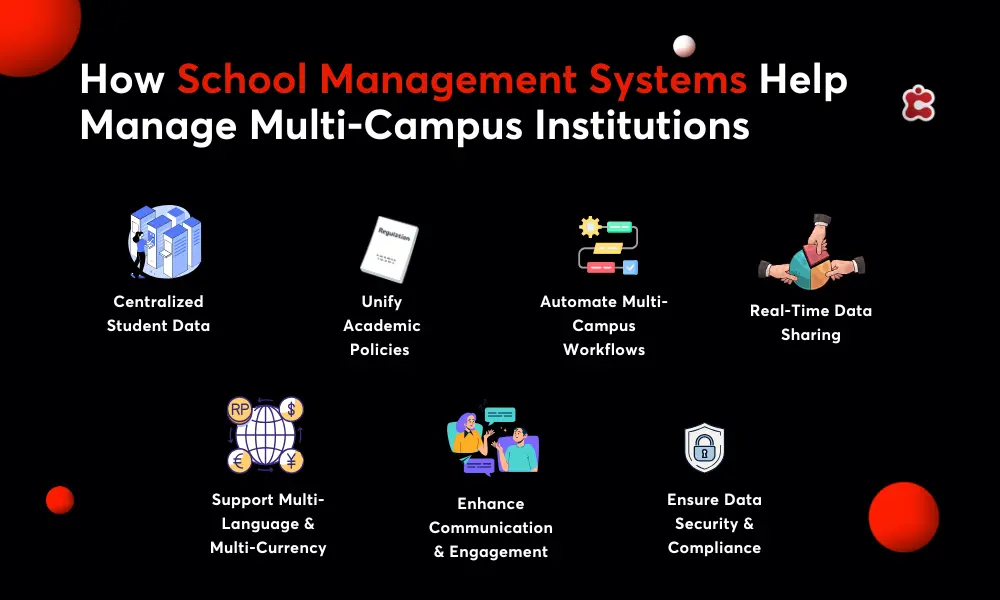Expansion into new campus locations is an exciting sign of growth and success for any educational institution. However, managing multiple campuses introduces significant operational complexity. Each site often operates separate systems for admissions, grading, communication, and finance, creating data silos, duplicated work, and inconsistent academic standards. This fragmentation makes it difficult for administrators to maintain oversight and ensure compliance across all locations.
A School Management System (SMS) provides a unified digital platform that connects every campus under one central system. It standardizes processes, enables real-time data sharing, and ensures consistent academic and administrative workflows.
We’ll explore how institutions can effectively manage multi-campus operations using School Management Systems. It outlines common challenges, key technology features, and best practices for creating a seamless, centralized management structure.

What Makes Multi-Campus Management Complex?
Data Fragmentation: When campuses use separate systems or manual spreadsheets, information becomes scattered and inconsistent.
Inconsistent Academic Standards: Different campuses may apply unique grading scales, attendance rules, or course structures.
Complex Student Transfers: Without shared systems, transferring students between campuses requires manual data entry and credit validation.
Compliance Risk: Managing student data across borders means complying with multiple regulations such as GDPR and FERPA. Disconnected systems make it harder to maintain data security and legal compliance.
Disjointed Communication: When staff, faculty, and students use separate communication channels, important updates are missed, and collaboration weakens.
Reporting Delays: Without a centralized data source, generating accurate reports is slow, limiting visibility into overall institutional performance.
Top ways School Management Systems Help Manage Multiple Campuses
A School Management System simplifies multi-campus management by connecting all operations, data, and users under one unified platform. It eliminates fragmentation and ensures every campus follows the same academic and administrative standards while maintaining local flexibility.
1) Centralized Student Information
An SMS provides a single, centralized student profile accessible across all campuses. This unified record includes academic history, financial details, and attendance data. Administrators and faculty can access accurate, real-time information, reducing duplication and improving decision-making.
2) Standardized Academic Frameworks
The system enforces shared grading scales, curriculum mapping, and academic policies across all campuses. Institutions can configure global standards within the system, ensuring fairness, consistency, and compliance with accreditation requirements.
3) Automated Multi-Campus Workflows
From admissions to graduation, SMS automates the entire student lifecycle. Updates made at one campus automatically sync across all others, reducing manual work and minimizing errors.
4) Integrated Communication Tools
Built-in communication features support real-time collaboration between students, faculty, and administrators. Multi-language messaging, announcements, and parent portals enhance engagement and ensure everyone stays informed—no matter the location.
5) Unified Finance and Billing
An SMS supports multi-currency transactions and centralized financial dashboards. Finance teams can manage tuition, fees, and payments for all campuses in one place, improving transparency and efficiency.
6) Advanced Reporting and Analytics
With comprehensive dashboards, administrators can monitor institutional performance by campus, department, or program. Real-time analytics provide the insights needed for data-driven decisions and continuous improvement.
Features to Prioritize in a Multi-Campus SMS Capability
| Feature | Why It Matters |
| Multi-Campus Architecture | Provides each campus with local control while maintaining centralized oversight and reporting. |
| Role-Based Access Control (RBAC) | Protects sensitive data by granting users access based on defined roles and responsibilities. |
| API and LMS/CRM Integrations | Connects core systems—Learning Management Systems (LMS) and Customer Relationship Management (CRM)—to create one unified digital environment. |
| Multi-Currency and Multi-Language Support | Enables consistent operations and communication across different countries and regions. |
| Cloud-Based Infrastructure | Delivers secure, real-time access to data from any location with minimal downtime. |
| Data Governance Engine | Enforces compliance with global and regional data protection standards such as GDPR and FERPA. |
Why Choose Classter for Multi-Campus Management
Classter enables universities with multiple campuses to manage academics, admissions, and operations through one centralized, cloud-based system. Designed for scalability, it ensures every location operates under the same academic and administrative standards while maintaining local flexibility.
Key Classter Features for Multi-Campus Institutions:
- Multi-Campus Structure: Manage multiple campuses or departments from one centralized database with shared academic rules and reporting.
- Unified SIS, LMS & CRM: Integrate student data, learning management, and communication tools across campuses for a connected academic experience.
- Automated Admissions & Transfers: Digitize application, enrollment, and transfer processes while maintaining consistent student records.
- Centralized Finance & Billing: Handle tuition, fees, and multi-currency transactions across regions from one platform.
- Global Compliance & Localization: Ensure adherence to GDPR and regional data laws with multilingual, multi-currency, and time-zone support.
- Real-Time Analytics: Provide leadership with unified dashboards for visibility across all campuses.
TMAI Unifies 12 International Campuses with Classter
The Master’s Academy International (TMAI), a nonprofit organization based in California, manages 12 member schools across multiple countries. As the network expanded, TMAI faced growing challenges in maintaining academic consistency, managing student data, and generating real-time reports across all locations. Their previous system lacked the flexibility and scalability needed for international coordination, particularly in grading, GPA calculations, and integration with existing learning tools.
By adopting Classter’s cloud-based Student Information System (SIS), TMAI achieved centralized management of academic and student data across its global network. The system’s unified database provided leadership teams with instant access to student records and performance analytics, while out-of-the-box integration with Canvas LMS created a seamless digital learning environment.
Ready to streamline operations across multiple campuses? Classter helps institutions like TMAI unify academic management, student data, and digital learning tools within one secure, cloud-based system. Simplify coordination, boost visibility, and ensure consistency across every location. Book a demo today to see how Classter supports global education networks.
FAQ’s
A multi-campus School Management System (SMS) unifies all campuses under one database, ensuring consistent academic standards, real-time data sharing, and centralized governance while allowing local flexibility in operations.
Without centralized software, institutions face data silos, inconsistent grading standards, manual errors, and compliance risks—especially when managing students and staff across different locations or countries.
Classter’s all-in-one architecture allows institutions to operate several campuses or departments within one centralized environment, maintaining unified data, policies, and reporting across all locations.

